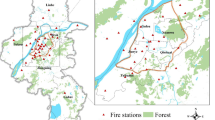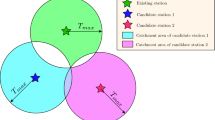Abstract
In recent years, with the rapid development of urbanization, the urban public emergency management faces increasing challenges, and the number of fire incidents has increased largely. For mitigating injury risk and reducing property loss, fire station locations need to be optimized to provide efficient fire emergency services. However, the locations of fire facilities in China are mainly determined according to administrative divisions, lacking effective data-driven applications. In addition, existing location models are designed for general purpose, and few have taken into account the unique characteristics of fire services with multiple objectives, i.e., maximum coverage, minimum overlapping coverage and balanced workloads. With the recent development of geospatial big data, lots of fire risk related data (e.g. fire incidents data and travel time data) can be obtained, which provides an unprecedented opportunity for urban fire emergency facilities planning. In this paper, we propose to establish the multi-objective maximal covering location model by accurately estimating fire rescuing demands and travel cost from geospatial big data. A case study was carried out in Nanjing, China, and the result shows that our method is effective in optimizing the locations of fire stations.











Similar content being viewed by others
References
Batta R, Lejeune M, Prasad S (2014) Public facility location using dispersion, population, and equity criteria. Eur J Oper Res 234(3):819–829
Chrissis JW (1980) Locating emergency service facilities in a developing area. Fire Technol 16(1):63–69
Church RL (2002) Geographical information systems and location science. Comput Oper Res 29(6):541–562
Church RL (1984) The planar maximal covering location problem. J Reg Sci 24:185–201
Church RL, Revelle C (1974) The maximal covering location problem. Papers of the Regional Science Association 32(1):101–118
Church RL, Sorensen P (1994) Integrating normative location models into GIS: problems and prospects with the p-median model. In: Longley P, Batty M (eds) Spatial analysis: Modelling in a GIS environment. GeoInformation International, Cambridge, pp 167–183
Coy SP, Golden BL, Runger GC, Wasil EA (2001) Using experimental design to find effective parameter settings for heuristics. J Heuristics 7(1):77–97
Curtin KM, Hayslett-McCall K, Qiu F (2010) Determining optimal police patrol areas with maximal covering and backup covering location models. Netw Spat Econ 10(1):125–145
Guo T, Fu Z (2007) The fire situation and progress in fire safety science and technology in China. Fire Saf J 42(3):171–182
Ha QM, Deville Y, Pham QD, Hà MH (2018) On the min-cost traveling salesman problem with drone. Transp Res C 86:597–621
Heller M, Cohon JL, Revelle CS (1989) The use of simulation in validating a multiobjective ems location model. Ann Oper Res 18(1):303–322
Hu W, Murray AT, Xiao N (2006) Solving the continuous space p-Centre problem: planning application issues. IMA J Manag Math 17(4):413–425
Indriasari V, Mahmud AR, Ahmad N, Shariff ARM (2010) Maximal service area problem for optimal siting of emergency facilities. Int J Geogr Inf Sci 24(2):213–230
Karatas M, Yakıcı E (2018) An iterative solution approach to a multi-objective facility location problem. Appl Soft Comput 62:272–287
Klose A, Drexl A (2005) Facility location models for distribution system design. Eur J Oper Res 162(1):4–29
Matisziw TC, Murray AT (2009) Siting a facility in continuous space to maximize coverage of a region. Socio Econ Plan Sci 43(2):131–139
Mehrez A, Stulman A (1982) The maximal covering location problem with facility placement on the entire plane. J Reg Sci 22(3):361–365
Maulik U, Bandyopadhyay S (2000) Genetic algorithm-based clustering technique. Pattern Recogn 33(9):1455–1465
Mehrez A, Stulman A (1984) An extended continuous maximal covering location problem with facility placement. Comput Oper Res 11(1):19–23
Murray AT, Matisziw TC, Wei H, Tong D (2008a) A Geocomputational heuristic for coverage maximization in service facility siting. Trans GIS 12(6):757–773
Murray AT, O’Kelly ME, Church RL (2008b) Regional service coverage modelling. Comput Oper Res 35:339–355
Murray AT, Tong D (2007) Coverage optimization in continuous space facility siting. Int J Geogr Inf Sci 21(7):757–776
Pirkul H, Schilling DA (1988) The siting of emergency service facilities with workload capacities and backup service. Manag Sci 34(7):896–908
Rajagopalan HK, Saydam C, Xiao J (2008) A multiperiod set covering location model for dynamic redeployment of ambulances. Comput Oper Res 35(3):814–826
Revelle C, Snyder S (1995) Integrated fire and ambulance siting: a deterministic model. Socio Econ Plan Sci 29(4):261–271
Revelle CS, Swain RW (2010) Central facilities location. Geogr Anal 2(1):30–42
Schilling DA, Revelle C, Cohon J, Elzinga DJ (1980) Some models for fire protection locational decisions. Eur J Oper Res 5(1):1–7
Tong D, Murray AT (2009) Maximising coverage of spatial demand for service. Pap Reg Sci 88(1):85–97
Toregas C, Revelle C (2005) Optimal location under time or distance constraints. Papers of the Regional Science Association 28(1):131–143
Wei R, Murray AT (2015) Continuous space maximal coverage: insights, advances and challenges. Comput Oper Res 62:325–336
Wesolowsky GO, Love RF (1971) Location of facilities with rectangular distances among point and area destinations. Naval Research Logistics Quarterly 18:83–90
Xia Z, Li H, Chen Y, Yu W (2019) Detecting urban fire high-risk regions using colocation pattern measures. Sustain Cities Soc 49:101607
Yang L, Yang S, Jones BF (2007) A fuzzy multi-objective programming for optimization of fire station locations through genetic algorithms. Eur J Oper Res 181(2):903–915
Yao J, Zhang X, Murray AT (2019) Location optimization of urban fire stations: access and service coverage. Comput Environ Urban Syst 73:184–190
Yu W (2019a) Discovering frequent movement paths from taxi trajectory data using spatially embedded networks and association rules. IEEE Trans Intell Trans Syst 20(3):855–866. https://doi.org/10.1109/TITS.2018.2834573
Yu W (2019b) A mathematical morphology based method for hierarchical clustering analysis of spatial points on street networks. Appl Soft Comput 85:105785. https://doi.org/10.1016/j.asoc.2019.105785
Funding
This work was supported by the National Natural Science Foundation of China [42071442, 41701440]; Natural Science Foundation of Hubei Province [2018CFB513]; Fundamental Research Funds for the Central Universities, China University of Geosciences (Wuhan) [CUG170640]; National Key Research and Development Program of China [2017YFB0503500]; Opening Fund of Key Laboratory of Geological Survey and Evaluation of Ministry of Education [GLAB2019ZR02]; a grant from State Key Laboratory of Resources and Environmental Information System [201801].
Author information
Authors and Affiliations
Corresponding author
Ethics declarations
Competing interests
The authors declare that they have no competing interests. We certify that the submission is original work and is not under review at any other publication.
Additional information
Communicated by: H. Babaie
Publisher’s note
Springer Nature remains neutral with regard to jurisdictional claims in published maps and institutional affiliations.
Rights and permissions
About this article
Cite this article
Yu, W., Guan, M. & Chen, Y. Fire stations siting with multiple objectives and geospatial big data. Earth Sci Inform 14, 141–160 (2021). https://doi.org/10.1007/s12145-020-00539-5
Received:
Accepted:
Published:
Issue Date:
DOI: https://doi.org/10.1007/s12145-020-00539-5




